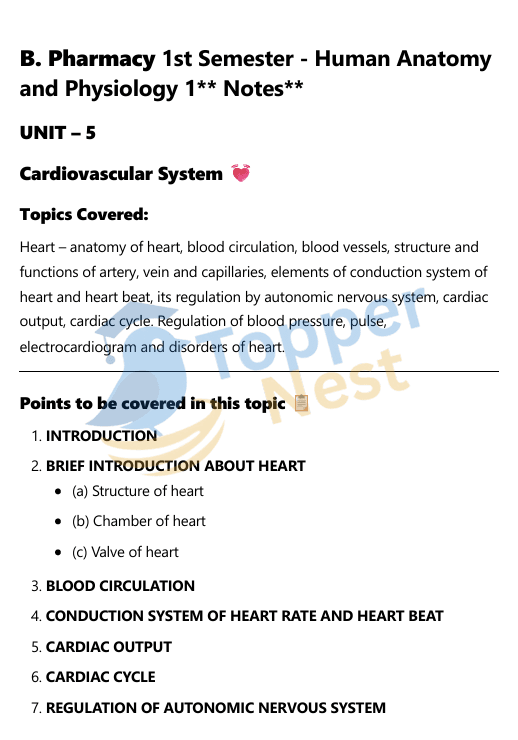The cardiovascular system is the body’s transport system. It is responsible for circulating blood, nutrients, hormones, and oxygen to various tissues and removing waste products. A thorough understanding of the cardiovascular system is essential for B. Pharmacy students, particularly in pharmacology, cardiology, and pathophysiology, where cardiovascular drugs play a central role.

What is the Cardiovascular System?
The Cardiovascular System, often referred to as the Circulatory System, is a vital organ system responsible for transporting essential substances throughout the body. It acts like a highly efficient internal delivery and waste removal network, crucial for maintaining overall health and life.
It’s a closed system, meaning blood is continuously circulated within a network of vessels and never leaves them, ensuring efficient transport.
Key Components of the Cardiovascular System:
- The Heart:
- This muscular pump, located in the chest cavity (left side of the body), is the central organ of the cardiovascular system that help blood circulation.
- It’s divided into four chambers: two upper chambers (atria – right and left) and two lower chambers (ventricles – right and left).
- The heart’s rhythmic contractions (heartbeat) propel blood through the vast network of blood vessels.
- Valves within the heart ensure preventing backflow and one-way blood flow.
- Blood Vessels: These are the intricate tubes that carry blood throughout the body. There are three main types:
- Arteries: Arteries are strong, elastic blood vessels designed to transport oxygen‑rich blood from the heart to various tissues throughout the body. Their walls are thick and muscular, allowing them to withstand the high pressure generated by the heartbeat and maintain a steady flow of blood.
- Veins: These vessels carry deoxygenated blood back to the heart from the body’s tissues. They often have valves to prevent blood from flowing backward, especially in the limbs. The largest veins are the superior and inferior vena cava.
- Capillaries: These are the smallest and most numerous blood vessels, forming a vast network that connects arterioles (small arteries) to venules (small veins). Their walls are extremely thin (often just one cell thick), allowing for the crucial exchange of oxygen, nutrients, and waste products between the blood and the body’s cells and tissues.
- Blood: This is the specialized fluid connective tissue that circulates throughout the system. It’s composed of:
- Plasma: The liquid component, mostly water, containing proteins, nutrients, hormones, antibodies, and waste products.
- Red Blood Cells (Erythrocytes): Responsible for carrying oxygen from the lungs to the body’s tissues and transporting carbon dioxide back to the lungs. They carry hemoglobin, a protein rich in iron that has the special ability to attach to oxygen molecules.
- White Blood Cells (Leukocytes): Part of the immune system, defending the body against infections, foreign substances, and abnormal cells. There are various types, each with specific immune functions.
- Platelets (Thrombocytes): Small cell fragments essential for blood clotting (hemostasis) to prevent excessive blood loss after injury.
Functions of the Cardiovascular System:
The primary functions of the cardiovascular system are extensive and vital for life:
- Transportation:
- Oxygen Delivery: Transports oxygen from the lungs to all cells and tissues of the body.
- Nutrient Delivery: Carries absorbed nutrients (e.g., glucose, amino acids, fatty acids) from the digestive system to cells for energy, growth, and repair.
- Waste Removal: Collects metabolic waste products (e.g., carbon dioxide, urea, lactic acid) from cells and transports them to organs of excretion (lungs for CO2, kidneys for urea).
- Hormone Transport: Carries hormones (chemical messengers) from endocrine glands to their target organs.
- Regulation:
- Body Temperature: Helps regulate body temperature by distributing heat throughout the body and by regulating blood flow to the skin (e.g., vasodilation to release heat, vasoconstriction to conserve heat).
- pH Balance: Plays a role in maintaining the body’s acid-base (pH) balance through buffer systems in the blood.
- Fluid Balance: Helps maintain proper fluid balance within the body’s tissues.
- Protection:
- Immunity: White blood cells in the blood are critical components of the immune system, defending against pathogens (bacteria, viruses, fungi) and foreign invaders.
- Clotting: Platelets and clotting factors in the blood prevent excessive blood loss through the formation of blood clots at sites of injury.
Circulation Pathways:
The cardiovascular system operates through two main circulatory loops:
- Pulmonary Circulation: Pulmonary circulation is the pathway through which blood travels from the right side of the heart to the lungs. In the lungs, the blood releases carbon dioxide and absorbs fresh oxygen. This oxygen‑enriched blood then flows back to the left side of the heart, ready to be pumped throughout the body.
- Systemic Circulation: This much larger circuit pumps oxygenated blood from the left side of the heart to all other parts of the body (organs, muscles, tissues), delivering oxygen and nutrients and collecting waste products. The deoxygenated blood then returns to the right side of the heart to complete the cycle.
FAQs
1. Why is the cardiovascular system important in pharmacy?
Because it is a major target for drug action in treating conditions like hypertension, arrhythmias, and heart failure.
2. What is the role of the SA node?
The SA node acts as the heart’s natural pacemaker, initiating electrical impulses for heartbeat.
3. What is the difference between an artery and a vein?
Arteries carry blood away from the heart, while veins carry blood back to the heart.
4. What does an ECG show?
It shows the heart’s electrical activity and is useful in diagnosing heart disorders.
5. What regulates blood pressure in the body?
Blood pressure is regulated by neural mechanisms (baroreceptors), hormones, and autonomic input.
